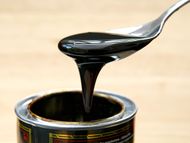Molasses: Difference between revisions
(Saving work, not done yet.) |
m (→Chemical Clarification: Clarified the clarification section to make sure it's understood that Milk of Lime is Calcium Hydroxide.) |
||
| Line 16: | Line 16: | ||
==Chemical Clarification== | ==Chemical Clarification== | ||
This section is being researched. | This section is being researched. | ||
Large rum houses use milk of lime and CO2 to clarify molasses. This method is impractical by small scale hobbyists | Large rum houses use Calcium Hydroxide (milk of lime) and CO2 to clarify molasses. This method is impractical by small scale hobbyists as usage ratios have not been established. | ||
<!-- Need to understand this better: http://aussiedistiller.com.au/viewtopic.php?f=25&t=5267&start=20 --> | <!-- Need to understand this better: http://aussiedistiller.com.au/viewtopic.php?f=25&t=5267&start=20 --> | ||
*[https://www.google.com/patents/US1687561 1928 patent for clarifying molasses] | *[https://www.google.com/patents/US1687561 1928 patent for clarifying molasses] | ||
*[https://www.google.com/patents/US2075127 1937 patent for clarifying molasses] | *[https://www.google.com/patents/US2075127 1937 patent for clarifying molasses] | ||
=External Links= | =External Links= | ||
Revision as of 11:56, 9 January 2019
A byproduct of the process that refines sugar found in Sugarcane into crystaline sugar. Molasses is often sold as sulfured or unsulfured. The sulfured kind of molasses may have a preservative in it which is harmful to yeast. Molasses is the sugar and nutrient source used when producing rum.
Molasses
Molasses or black treacle (British, for human consumption; known as molasses otherwise), is a viscous product resulting from refining sugarcane or sugar beets into sugar. Molasses varies by amount of sugar, method of extraction, and age of plant. Sugarcane molasses is agreeable in taste and aroma, and is primarily used for sweetening and flavoring foods in the United States, Canada, and elsewhere, while sugar beet molasses is foul-smelling and unpalatable, so it is mainly (mostly) used as an animal feed additive in Europe and Russia, where it is chiefly produced. Molasses is a defining component of fine commercial brown sugar.
Citrus Molasses
Citrus Molasses is a by-product of citrus juice extraction. The fresh pulp obtained after pressing the fruit is mixed with lime and pressed to remove moisture. The resulting liquid (press juice) is screened to remove the larger particles, sterilized by heating and concentrated. The resulting product contains 71-72% dry matter and 60-65% sugars. Citrus molasses is a thick viscous liquid, dark brown to almost black, with a very bitter taste. It is often sold to distilleries or reincorporated in the dried citrus pulp, but can also be fed directly to animals, or added to grass silage.
Clarifying Molasses
Molasses contains significant non-sugar components. Ash can take up from 5% to 15% or more depending on the grade. Clarifying reduces the non-sugar content. This process has not been proven to either help or hurt the flavor of the distillate.
Simple Clarification
Add 2 part water to 1 part molasses. Heat to no higher than 140f. Heating higher than 140f can cause Caramelization or the Maillard Reaction to occur. Leave the mixture overnight and rack off the top until you reach the solids layer.
Chemical Clarification
This section is being researched. Large rum houses use Calcium Hydroxide (milk of lime) and CO2 to clarify molasses. This method is impractical by small scale hobbyists as usage ratios have not been established.
